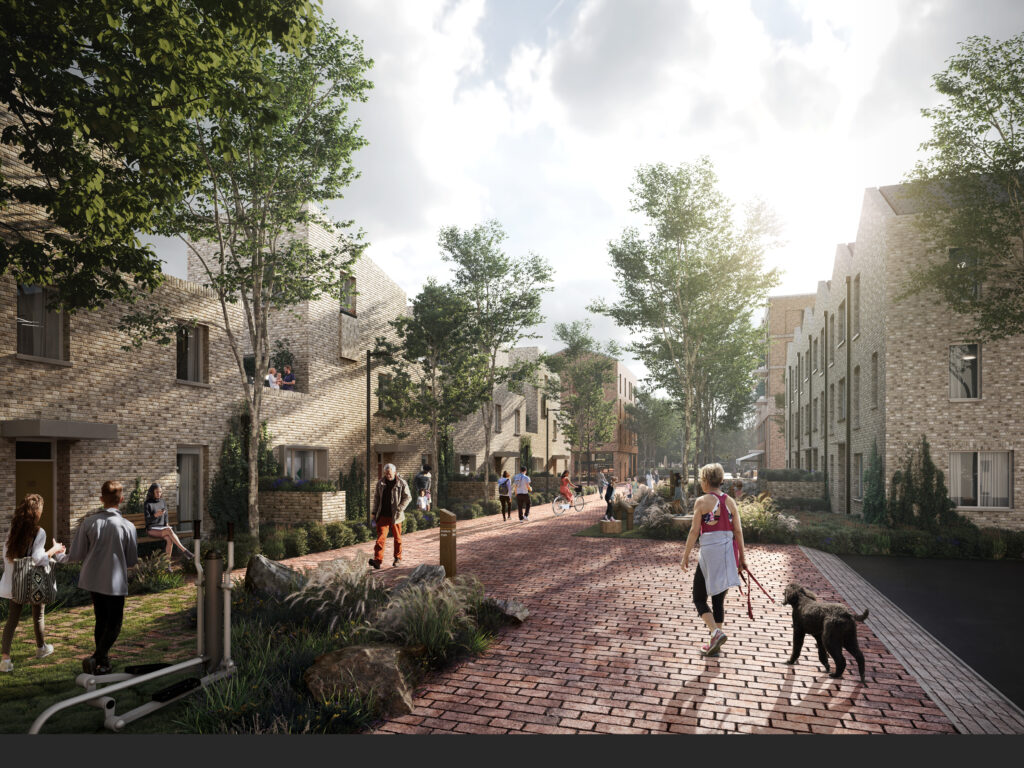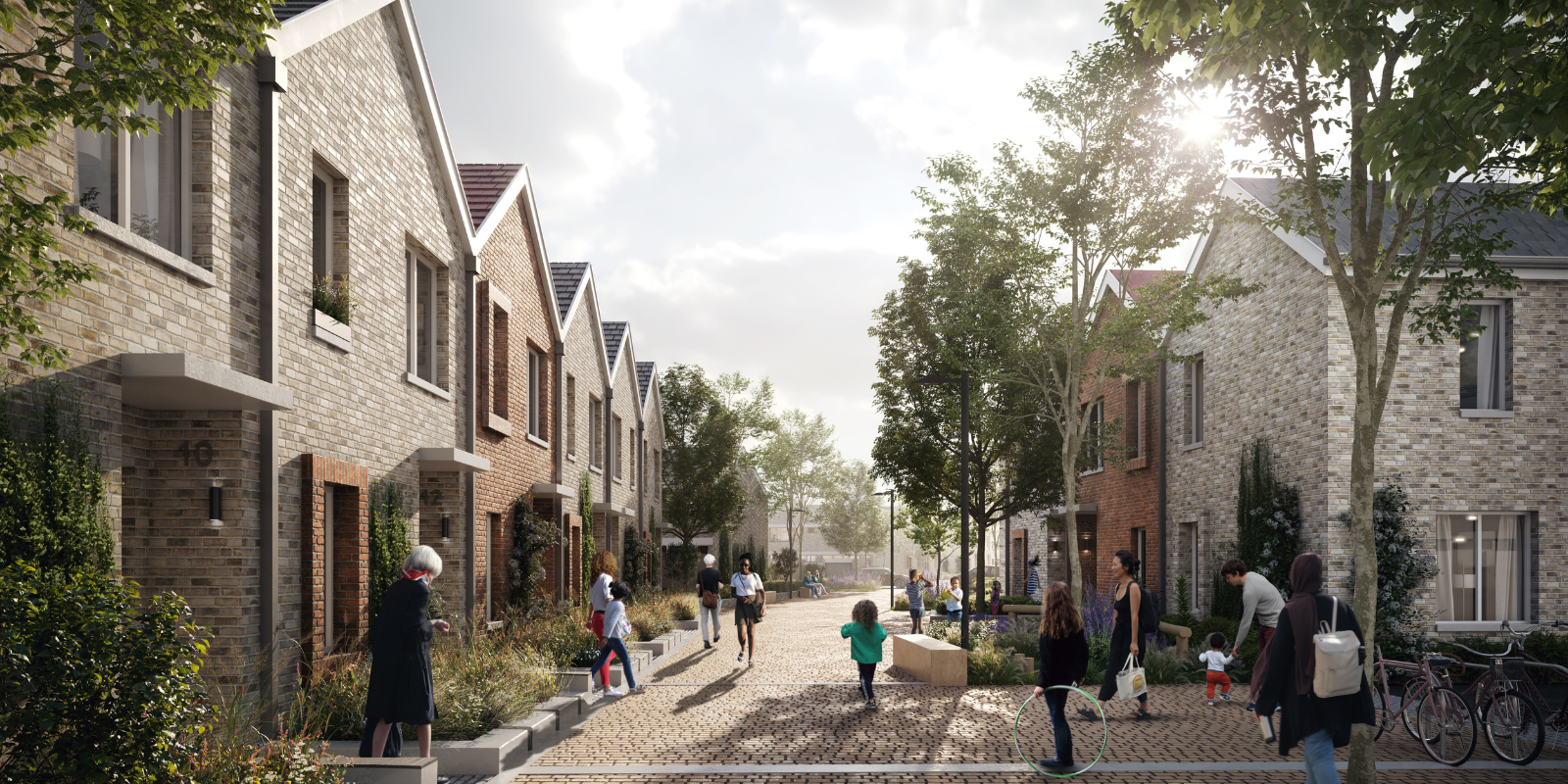Built in the heyday of the car, as overspill Council housing for London, the Abbey Estate in Thetford, Norfolk is a classic example of a 1960’s Radburn layout. Despite being designed with the good intention of safely separating cars and pedestrians, the Radburn layout has resulted in convoluted, confusing streets, spaces and cul-de-sacs that feel unobserved and unsafe.
Despite a strong community spirit, the estate today ranks in the top 7% of the most deprived areas in England and the community are challenged by poor health, lack of opportunities and access to Thetford, as well as high levels of social isolation, fly tipping and anti-social behaviour.
Social landlord, Flagship Group own 60% of the homes on the estate and are working on a long-term regeneration project to fundamentally improve the estate and enhance the lives and opportunities of the community who live there. They are developing a radical, co-produced masterplan, fit for the challenges of the 21st Century and beyond.
Who and where?
Flagship Group: a social landlord
Levitt Bernstein: a multi-disciplinary design practice
Abbey Estate, Thetford, Norfolk
Features and Principles highlighted
- well connected paths, streets and spaces (Feature)
- empowered communities (Feature)
- long term investment (Principle for success)

The challenge
The settlement of Thetford dates to the Iron Age, but from the 1950s Thetford became an ‘overspill town’, rapidly expanding to include a re-located population from London.
Extensive building of new homes was required as the population increased, including in 1967, the construction of the Abbey Farm Estate – 1,100 houses, public open spaces and footpaths.
The estate, as many ‘overspill town’ estates at that time, was planned in line with Radburn layout principles – notably employing cul-de-sacs and typified by the fronts of homes facing one another, over common yards rather than the street. Car parking courtyards and garage blocks were placed to the rear of homes, accessed by alleys. Radburn layouts have been criticised for resulting in an absence of properly overlooked streets and encouraging crime and anti-social behaviour. The urban principles of the Radburn System are accused of contributing to places that lack prosperity, pride, or opportunities for healthy and happy lifestyles. The current Radburn layout encourages private vehicle use for short journeys and ‘hides’ neighbourhood facilities and the retail and community centre of the estate.
The Abbey Estate today ranks in the top 7% of most deprived areas in England and despite strong community cohesion, the community struggle with challenges including worklessness, poor health and wellbeing, social isolation, lack of access to healthy food, fly tipping, anti-social behaviour, poor connections across the estate and poor access to local assets including the Little Ouse River, Thetford Forest and Thetford town centre.
Flagship Group, a social landlord in the East of England, own 60% of the homes on the estate and work to support their tenants and the wider community through the provision of homes and sustainable communities.
Recognising the need for change and investment, Flagship Group have a long-term ambition to regenerate the estate:
The vision is to enhance lives and opportunities, not deliver something cosmetic or mediocre because if we do that, we’ll be back here in 30 years. This is about long-term change, creating long term change and seeing the value in that.
James Payne, Regeneration Director, Flagship Group
The solution
In 2018 Flagship Group engaged Levitt Bernstein, a multi-disciplinary design practice to develop masterplan options for the estate that include the addition of new housing as well as varying degrees of re-development of the existing housing stock, environment and landscaping. The approach is that new homes are a mechanism to solve problems and improve the estate for all.
Key to developing the masterplan options has been a community engagement and empowerment strategy recognising that both Flagship and Levitt Bernstein cannot truly know how the estate operates, what it is like to live in and what the community care about.
The core of what we’ve been trying to do, is to use experiences, to use knowledge to feed us, to develop the right solutions, to hone the right solutions.
James Payne, Regeneration Director, Flagship Group
Improving the connectivity of the estate is described by the team as the ‘big story’ of the project. The proposed changes stitch the estate into the wider context of Thetford (the town centre, railways station and local heritage site) and re-connect the community to the natural assets that surround the estate (the forest and the river). This approach is proposed in tandem with improvements to the permeability of the estate, creating safe, fun, efficient active travel routes that allow people to confidently move through the estate and beyond.
All of this is proposed to drive systemic improvements for the community – increasing physical activity and health, greater community cohesion, improved access for all to local facilities, access to wider opportunities and increased access to high quality green infrastructure.
The heart of masterplan is ultimately the movement strategy, active travel and connectivity which will deliver systemic improvements.
James Payne, Regeneration Director, Flagship Group
The plan also envisages that improved connectivity could bring more Thefordians in and through the estate, to visit the proposed enviable asset of a new community park, using active travel routes to the forest, or along the river. This could help break down the stigma and unfair local reputation that the Abbey Estate has as run-down and undesirable.
Key lessons
- Empowered communities (Feature)
Flagship Group and Levitt Bernstein from the outset committed to on-going, transparent dialogue with the Abbey Estate community, aware that they were planning change to people’s homes, places of memory, hope and security, and that the regeneration project includes integrating new and old and will takes years to design and implement. The engagement strategy has resulted in 1000s of interactions on the masterplan options and is about trust, honesty and challenging misinformation.
This type of engagement is not easy.
Our commitment is to respond genuinely and sincerely to the feedback that we get. And whilst that is great, my word that is challenging, you have to really think, and you have to dig deep and you toil over that detail.
James Payne, Regeneration Director, Flagship Group
A key tool in engaging the community has included acting on short term challenges that the community identify, commissioning ‘meanwhile’ uses and implementing incremental changes to improve things for the community now. These meanwhile uses create momentum and build trust, whilst improving lives. So far these have included working on a plan for better connection for residents to the river and improved lighting at the heart of the estate.
- Investment in long-term place-shaping (Principle for success)
Better connections, behaviour change, modal shifts, healthier populations are all challenges that no single development or re-development proposal can change. Flagship Group consider that currently planning and planning policy remain too focused on changes within red lines rather than systemic approaches to making healthier, more active places and realising the benefits that will bring to individuals, communities and society.
A redevelopment project like the Abbey Estate is challenging for everyone concerned because it is about adapting, maybe over the course of a generation, an existing place in ways that may not fit within the confines of current policy or may require hard discussions over, for example, reducing the quantity of greenspace to increase quality greenspace.
- Connected paths, streets and spaces (Feature)
Connection and permeability are key principles in the master planning options and seen as essential to driving improvements across a wide range of estate’s challenges. The community identified that it is not easy to move around the estate or to get to assets and opportunities that are geographically close, but inaccessible physically and psychologically.
Increased active travel and mobility for all through connected, interesting, fun, safe routes will change the way the built environment and the community interact.
What next?
A final public exhibition of the masterplan options took place with the community in the Autumn 2022. The current project timeline envisages an application for outline planning permission to be submitted to the Local Planning Authority in 2023. Meanwhile uses will continue to be discussed with the community in the meantime.
With thanks to:
James Payne – Regeneration Director, Flagship Group
Callum James -Regeneration Project Manager, Flagship Group
Glyn Tully –Associate Director, Head of Urban Design, Levitt Bernstein
For more information, please see:
Abbey Estate — Levitt Bernstein
Creating Connected Places (tcpa.org.uk)
THE URBAN IDIOT: Radburn – Here & Now (theaou.org)
Town Expansion and Migration – Thetford Town Council
Kilpatrick, Brendan; Patel, Manisha (2020). Estate Regeneration: Learning from the Past, Housing Communities of the Future. Routledge. p. 131-139.

